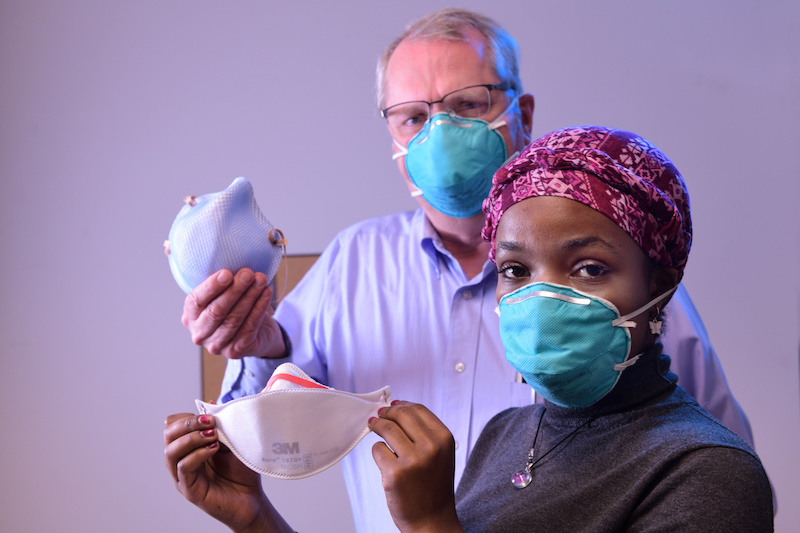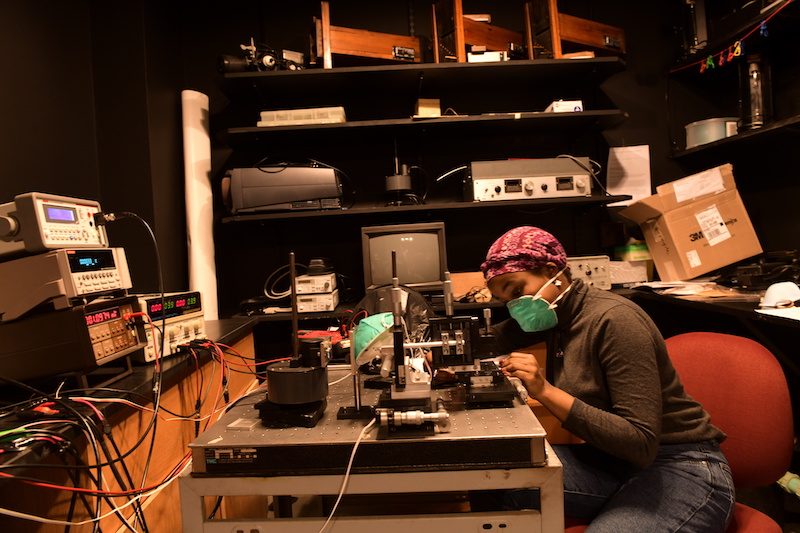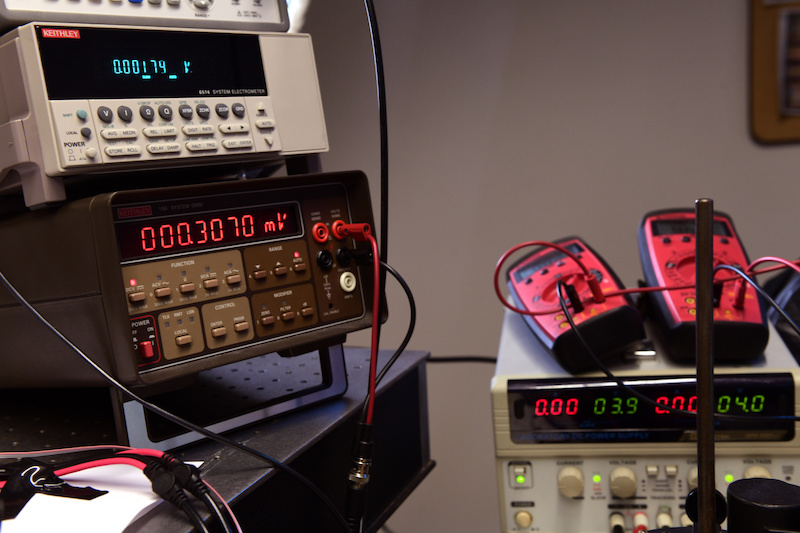Professor and Student Make Breakthroughs on Cheap, Effective Way to Sterilize PPE
By Rebecca Goldfine
In March of 2020, Syphers was in the middle of his sabbatical, working on a book about case studies in forensic physics. But when the pandemic hit, he “turned on a dime,” focusing instead on how ultraviolet (UV) light can be deployed in the fight against COVID-19 and other viruses.
"Physics is highly applicable to a wide range of things," Syphers said. He put away his project about accident reconstructions—for now—to contribute to public health. He received funding from Bowdoin to invest in new lab equipment to begin experimenting with UV light. "It became clear to me that I was the only one, being on sabbatical, who really had the time and energy to throw into this project," he said.
At about the same time last year, Bor was at loose ends. She was unable to return to her home in Kenya for the summer because of pandemic-related travel restrictions. She asked Syphers if she could assist him. "It sounded very interesting to me and it was very timely," she said.
Getting drawn into the work, she continued assisting him through the fall and spring semesters as an independent study, and will extend the work through this summer, possibly turning it into an honors project next year.

The Syphers lab in Searles. The lab has to be kept dark so the UV light can be measured accurately. To get precise data for the transmission and reflection properties of UV light, Bor and Syphers take apart each N-95 mask to expose every individual filter layer with UV light.
Deconstructing Masks
In the early days of the pandemic, officials in the US worried that health care providers might confront a shortage of personal protective equipment (PPE), particularly face masks. If this proved to be the case, being able to reuse masks could alleviate pressure on hospital systems, both in the US and around the world.
The most highly effective medical mask is the N-95 respirator, which is made up of layers of synthetic material that filter out tiny particles in the air, including viral droplets. These droplets can be deactivated by exposure to shortwave ultraviolet light, as it renders viruses unable to reproduce. The problem is that, over time, repeated exposure to UV light can degrade the mask material, making them ineffective and unsafe.
Syphers and Bor have spent the past year characterizing how UV light passes through N-95s. With this knowledge, they've been able to determine the shortest amount of time different respirators need to be exposed to the light, and at what level, to render viral loads inactive.
They have found that, for the majority of masks, 99 percent of the viral load is killed within the first few seconds of UV exposure. But the remaining 1 percent takes twenty times longer to become deactivated. As UV beams penetrate a mask, photons bounce off the fibers of the filter layers. Some of the UV light bounces backwards before doubling back and piercing the mask, slowing down the deactivation process.
Their insight into the mechanism behind the sterilization process can be applied to a variety of medical masks. “As a result of understanding how the UV light goes through these filters, we can enlarge the pool and make other respirators cleared for use,” Syphers said. He plans to publish his findings with Anant Agrawal, a researcher at the Food and Drug Administration.
Syphers and Bor are also collaborating with a virologist at the University of New England and doing their UV exposure experiments in a box constructed specifically for deactivating viruses on N-95s. The intention is to send these boxes, with assistance from international relief agencies, to clinics around the world.
Joyce Bor decided as a little girl that she wanted to be an engineer like her father, who worked for a tea company in Kenya. When he took her to visit tea processing factories, she would always be most enthralled with the machinery.
In Kenya, students are expected to choose a distinguished career path—law, medicine, teaching, engineering, etc.—and stick with it through secondary school and university. At Bowdoin, while Bor has adhered to her original plan and is majoring in physics, she said she has enjoyed the many other classes she has taken, including dance, theater, and religion.
"I am glad I have the chance to do that," she said, "because, as I learn more and more, I am not the same person I was."
In her work with Syphers, she's become interested in how physics can be applied to health care. "There is a lot of need for innovation in the medical field, and physics can be helpful in that regard," she said.
"I come from a place that is underprivileged—we don't have enough hospitals, and the hospitals we do have don't have enough supplies and medicine. So it is very inspiring to think that one person can work with others to make big things happen."

“In the long run, we believe the UV box under development could be especially useful in areas of the world with limited means, allowing N-95 respirators to be reused safely up to twenty-five times, and probably useful here in the US for everything from EMTs to doctors’ offices and hospitals,” Syphers said.
"There is so much need right now, and the people involved are not interested in making money, they’re interested in helping," he added.
Plus, the findings Syphers and Bor have made into how UV light bounces off mask fibers could lead to better-designed masks that can be reused even more, perhaps hundreds of times, saving resource-strapped hospitals a lot of money.
The two will continue their work this summer, collecting more data on how light moves through the mask's filter layers. "The end result should be a complete description of how the virus load is deactivated. No other group that I’m aware of is involved in this level of detail," Syphers said.